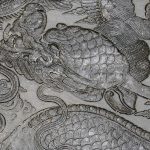Returning to the Mother
Folklore from the Hue region tells how King Thieu Tri and his entourage traveled upstream on the Huong (Perfume) River so the monarch could inspect the construction of his tomb. As they passed Ngoc Tran Temple, one of his concubines accidentally dropped a gold spittoon overboard, into deep water. Fearful of punishment, the concubines begged the king to pray to the goddess Thien Y A Na. With a somewhat mocking demeanor, the king stood at the boat’s bow and prayed. Miraculously, the spittoon slowly rose to the surface, an apparent manifestation of divine intervention. Witnessing this miracle, the king promised to renovate the temple, but passed away before fulfilling his vow.

Situated atop Ngọc Tran Mountain—a summit with a rounded shape compared to an overturned bowl beside the Perfume River—Hon Chen (or Hue Nam) Temple was originally a small shrine dedicated to the mountain goddess Ngoc Tran, the guardian goddess of the Ngoc Tran region and its surroundings.
During the early Nguyen Dynasty, like many other shrines dedicated to female deities located at treacherous bends of the Perfume River, the shrine on Ngoc Tran Mountain was modest in scale and not yet included as a site for royal rituals of the monarchic court. The splendid appearance of Hue Nam Temple today is due to King Dong Khanh, who devoted his life to the Mother Goddess and declared himself the seventh saint in the hierarchy of Mother Goddess worship, inscribing:
“… the sacred mountain of the celestial maiden shines beautifully for eternity, clearly resembling a lion drinking from the river, truly a divine paradise. This temple, blessed with the most potent spiritual energy, saves people, brings blessings, and aids in protecting the nation; thus, it shall be renamed Hue Nam Temple to symbolize the nation’s gratitude, even if only a fraction of the whole.”

Since King Dong Khanh’s era, Hon Chen/Hue Nam Temple has maintained its distinctive architecture, characterized by double roofs typical of Hue, glazed tile roofs, porcelain inlays along the roof ridges, and soaring phoenix motifs as a hallmark of this shrine dedicated to the goddess.
The temple devoted to the goddess Thien Y A Na is divided into three main sections aligned vertically, facing the river: Minh Kinh Cao Dai (First Hall), Minh Kinh Trung Dai (Second Hall), and Minh Kinh Tien Dai (Third Hall). The highest and most solemn space, Minh Kinh Cao Dai, is where the Holy Mother and the seven saints are worshiped. From this elevated position, the Holy Mother gazes down upon the Perfume River, providing protection and blessings to her devotees.

“July is for the commemoration of Father, March is for the commemoration of Mother,” is an old saying. Every year, during the Holy Mother’s Festival in the seventh lunar month, the Hue Nam Temple Festival draws tens of thousands of devotees from across the nation, who gather under Huong Uyen Hill. They arrive on rafts formed from pairs of traditional Hue boats, adorned with lanterns and flowers. The pilgrims prepare altars, offerings, and ceremonial attire to fully immerse themselves in three days of spiritual communion as mediums serving the Holy Mother.

After the main ritual at Hue Nam Temple, devotees join a sacred procession of the Holy Mother through Hai Cat Village, which lies beside the temple. Here, many generations have revered Thien Y A Na as their village deity. Amidst the reverberating sounds of ceremonial music, the Mother is carried onto a raft, accompanied by a procession of various spirits from the Four Palaces, including Supervisors, Supervisors of the Mountain, Pathfinding Commissioners, and countless other spirits. Upon reaching Hai Cat Village, the Mother’s spirit tablet is brought into the communal house. Here, the Mother joins the villagers for a night of festivities, receiving their offerings during the village’s autumn festival, bestowing blessings, and relieving their burdens through oracles and spirit mediums before returning to Hue Nam Temple the next morning.

According to elders, the Hue Nam Temple Festival once featured both land and water processions, each with its own distinct customs and ceremonial escort teams. The land procession was particularly notable in Hue, showcasing a diverse array of ethnic groups and social classes, from highland minorities in the West to riverine residents. This procession resembled a colorful masquerade, with the red realm of Heaven, the yellow realm of Earth, the black or indigo of the Water Palace, and the white or green of the Highlands.

During their night of festivities with villagers from Hai Cat, the accompanying spirits honor the Mother through various spirit mediums representing esteemed figures such as Tôn Ông, Đức Bà, and various princesses and princes on rafts anchored in front of the village communal house. In a space representing the ethereal realms of Heaven, the Highlands, and Water Palaces below, each place hosts deities to celebrate the Mother. A vibrant tableau unfolds with torchbearers, fan wavers, boat rowers, sword dancers, and incense bearers surrounding the Mother, enhancing the solemnity of her return. Simultaneously, the assistant mediums meticulously attend to the mediums, offering towels, pouring wine, lighting cigarettes, and preparing betel leaves, expressing solidarity and gratitude, and sharing in the divine blessings along with fellow devotees and pilgrims.






